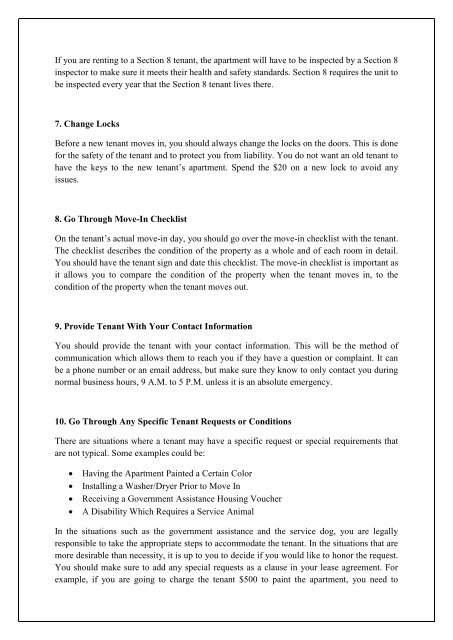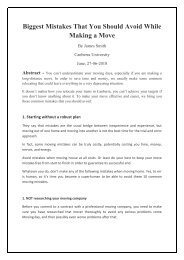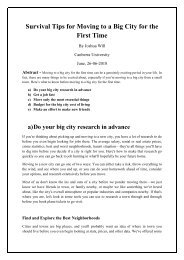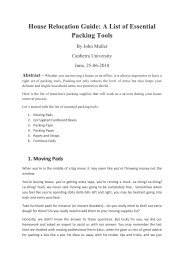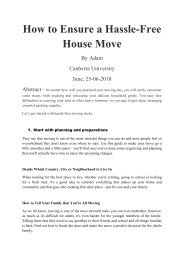What to do when moving out of a rental property tenant move out checklist
You also want an ePaper? Increase the reach of your titles
YUMPU automatically turns print PDFs into web optimized ePapers that Google loves.
If you are renting <strong>to</strong> a Section 8 <strong>tenant</strong>, the apartment will have <strong>to</strong> be inspected by a Section 8<br />
inspec<strong>to</strong>r <strong>to</strong> make sure it meets their health and safety standards. Section 8 requires the unit <strong>to</strong><br />
be inspected every year that the Section 8 <strong>tenant</strong> lives there.<br />
7. Change Locks<br />
Before a new <strong>tenant</strong> <strong>move</strong>s in, you should always change the locks on the <strong>do</strong>ors. This is <strong>do</strong>ne<br />
for the safety <strong>of</strong> the <strong>tenant</strong> and <strong>to</strong> protect you from liability. You <strong>do</strong> not want an old <strong>tenant</strong> <strong>to</strong><br />
have the keys <strong>to</strong> the new <strong>tenant</strong>’s apartment. Spend the $20 on a new lock <strong>to</strong> avoid any<br />
issues.<br />
8. Go Through Move-In Checklist<br />
On the <strong>tenant</strong>’s actual <strong>move</strong>-in day, you should go over the <strong>move</strong>-in <strong>checklist</strong> with the <strong>tenant</strong>.<br />
The <strong>checklist</strong> describes the condition <strong>of</strong> the <strong>property</strong> as a whole and <strong>of</strong> each room in detail.<br />
You should have the <strong>tenant</strong> sign and date this <strong>checklist</strong>. The <strong>move</strong>-in <strong>checklist</strong> is important as<br />
it allows you <strong>to</strong> compare the condition <strong>of</strong> the <strong>property</strong> <strong>when</strong> the <strong>tenant</strong> <strong>move</strong>s in, <strong>to</strong> the<br />
condition <strong>of</strong> the <strong>property</strong> <strong>when</strong> the <strong>tenant</strong> <strong>move</strong>s <strong>out</strong>.<br />
9. Provide Tenant With Your Contact Information<br />
You should provide the <strong>tenant</strong> with your contact information. This will be the method <strong>of</strong><br />
communication which allows them <strong>to</strong> reach you if they have a question or complaint. It can<br />
be a phone number or an email address, but make sure they know <strong>to</strong> only contact you during<br />
normal business hours, 9 A.M. <strong>to</strong> 5 P.M. unless it is an absolute emergency.<br />
10. Go Through Any Specific Tenant Requests or Conditions<br />
There are situations where a <strong>tenant</strong> may have a specific request or special requirements that<br />
are not typical. Some examples could be:<br />
<br />
<br />
<br />
<br />
Having the Apartment Painted a Certain Color<br />
Installing a Washer/Dryer Prior <strong>to</strong> Move In<br />
Receiving a Government Assistance Housing Voucher<br />
A Disability Which Requires a Service Animal<br />
In the situations such as the government assistance and the service <strong>do</strong>g, you are legally<br />
responsible <strong>to</strong> take the appropriate steps <strong>to</strong> accommodate the <strong>tenant</strong>. In the situations that are<br />
more desirable than necessity, it is up <strong>to</strong> you <strong>to</strong> decide if you would like <strong>to</strong> honor the request.<br />
You should make sure <strong>to</strong> add any special requests as a clause in your lease agreement. For<br />
example, if you are going <strong>to</strong> charge the <strong>tenant</strong> $500 <strong>to</strong> paint the apartment, you need <strong>to</strong>


